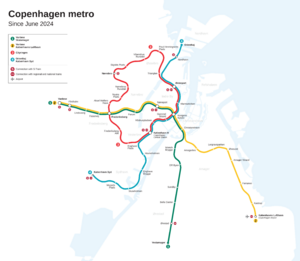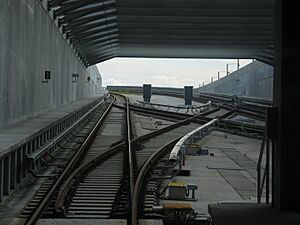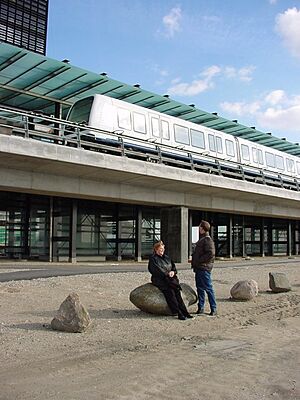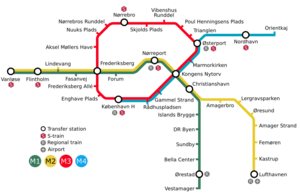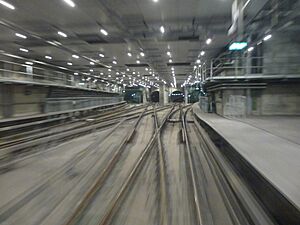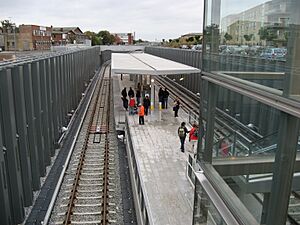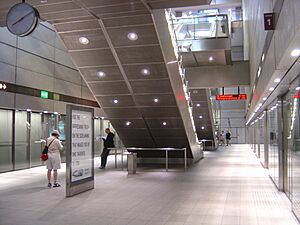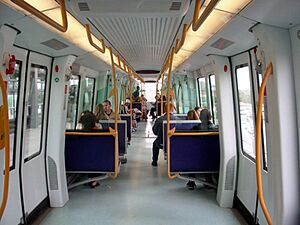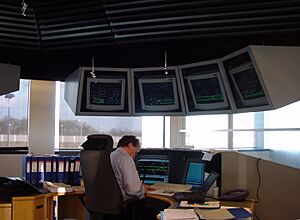Copenhagen Metro facts for kids
Quick facts for kids Copenhagen Metro |
|
|---|---|
 |
|
| Info | |
| Owner | Metroselskabet I/S |
| Locale | Copenhagen, Denmark |
| Transit type | Light rapid transit |
| Number of lines | 4 (1 planned) |
| Number of stations | 44 |
| Daily ridership | 360,000 (daily) |
| Chief executive | Carsten Riis, CEO |
| Website | M.dk |
| Operation | |
| Began operation | October 19, 2002 |
| Operator(s) | Inmetro |
| Number of vehicles |
|
| Train length | 3 cars |
| Headway | 2–4 minutes |
| Technical | |
| System length | 43.3 km (26.9 mi) |
| Track gauge | 1,435 mm (4 ft 8 1⁄2 in) standard gauge |
| Electrification | 750 V DC third rail |
| Average speed | 40 km/h (25 mph) |
| Top speed |
|
The Copenhagen Metro (Danish: Københavns Metro) is a modern train system in Copenhagen, Denmark. It helps people travel around the city and nearby areas like Frederiksberg and Tårnby.
This metro system first opened in October 2002. It's special because its trains run without drivers! It works alongside the bigger S-train system and connects with local trains and buses. The metro has 4 lines and 44 stations. Most of these stations, 30 of them, are underground.
The M1 and M2 lines serve different parts of Amager, including Copenhagen Airport. They share a track in the city center. The M3 is a circular line that runs completely underground, connecting many parts of Copenhagen. The M4 line helps the M3 and connects to Nordhavn and Sydhavn. A fifth line, M5, is being planned and is expected to open around 2035. In 2023, the metro carried 120 million passengers. The Copenhagen Metro is one of the few train systems in the world that runs 24 hours a day, every day!
Contents
How the Metro Works
The metro system is owned by a company called Metroselskabet. This company is owned by the cities of Copenhagen and Frederiksberg, and the Danish government. The M1 and M2 lines use 34 trains. These trains are about 2.65 meters wide and have three cars. They get their power from a 750-volt third rail system.
A private company called Metro Service A/S runs the metro. Trains run all day and night. During the day, trains come every two to four minutes. At night, they come less often, about every twenty minutes.
Planning for the metro began in 1992. Construction started in 1996. The first part of the metro opened in 2002, connecting Nørreport to Vestamager and Lergravsparken. More sections opened in 2003 and 2007, including the line to Lufthavnen (the airport).
The City Circle Line (M3) is a 15.5-kilometer loop that runs entirely underground. It has 17 stops and connects many central areas of Copenhagen. This line does not share tracks with M1 and M2. However, you can switch between lines at Kongens Nytorv and Frederiksberg stations. When the City Circle Line opened, it was expected to almost double the number of people using the metro.
The M4 line is an extension of the M3. It connects to Nordhavn and Sydhavn. The first M4 stations in Nordhavn opened in March 2020. The five-stop extension to Sydhavn opened in 2024. The M4 line connects to the S-train network and other regional trains. The metro expects to carry 600,000 passengers every weekday by 2030.
Metro History
Early Planning and Choices
The idea for the metro came from plans to develop the Ørestad area of Copenhagen. In 1992, the Danish Parliament decided to build a rail system. They looked at different options: trams, light rail, and rapid transit. In 1994, they chose the rapid transit system, which is what the metro is today.
The metro was chosen because it offered the fastest travel times and could carry the most passengers. It also had less impact on the environment and fewer accidents. Even though it cost more to build, it was seen as the best long-term choice.
In 1994, decisions were made to build more sections of the metro. Different companies were created to manage these projects. In 1996, a contract was signed with a group called Copenhagen Metro Construction Group (COMET) to build the lines. Another company, Ansaldo STS, was chosen to provide the technology and trains, and to run the system for the first five years.
Building Lines M1 and M2
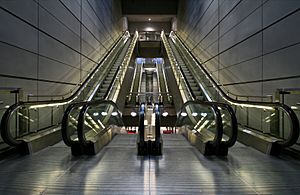
Construction began in November 1996. Workers started by moving underground pipes and wires. In 1997, work began on the train depot. Two special machines, called tunnel boring machines (TBMs), arrived in late 1997. They started digging the tunnels in February 1998. The same month, the government approved the driverless metro system.
The first tunnel section was finished in September 1998. By December 1998, work had started on the first nine stations. In May 1999, the first trains arrived for testing. The tunnels were completed in February 2001.
On October 19, 2002, the first section of the metro opened. This ran from Nørreport to Lergravsparken and Vestamager. At first, trains came every 12 minutes, but this quickly improved to every 6 minutes. Ansaldo, through Metro Service, managed the operations.
Opening and Expanding M1 and M2
More sections of the M1 and M2 lines opened in 2003. The section from Nørreport to Vanløse opened in May and October 2003.
In 2005, a final agreement was made to build the City Circle Line (M3). This was a big project. In 2007, the company that owned the metro, Ørestad Development Corporation, was replaced by Metroselskabet I/S.
The M2 line was extended to the airport on September 28, 2007. This 4.5-kilometer section mostly followed an old railway line. In April 2008, the Copenhagen Metro won an award for being the world's best metro system. Judges praised its reliability, safety, and passenger satisfaction. In 2008, the number of passengers grew by 16%, reaching 44 million per year.
Since March 2009, the metro has operated 24 hours a day, every day of the week. This was a challenge because maintenance usually happens at night. So, the system was designed to run on a single track at night, leaving the other track free for work.
Building Lines M3 and M4
The City Circle Line (M3) opened on September 29, 2019. This line is completely separate from the M1 and M2 lines. It circles the city center, connecting areas like Østerbro, Nørrebro, and Vesterbro to Frederiksberg and Indre By. The line is 15.5 kilometers long and runs entirely in tunnels. It takes about 25 minutes to complete a full loop.
Lines M3 and M4 share some stations. The M3 trains run around the entire circle in both directions. The M4 line opened on March 28, 2020, with two new stations in the Nordhavn district. This line runs from Copenhagen Central Station (København H) to Orientkaj station in Nordhavn. It shares six stations with the M3.
An extension to the Sydhavn district opened on June 22, 2024. This extension is served by the M4 line. It moved the M4's southern end from Copenhagen Central Station to København Syd.
There were plans for a northwest extension of the City Circle Line, but these were changed. Instead, the M4 was extended to Nordhavn. The southern extension of the M4 now runs from Copenhagen Central Station through Sydhavn to Ny Ellebjerg. Here, the M4 connects with the S-train and regional train systems.
The M4 line, also called the Harbour line, shares tracks with the M3 between Copenhagen Central Station and Østerport station. The completed M4 line between Orientkaj and Ny Ellebjerg has 13 stations.
As of 2024, the metro system has four lines and 44 stations. Eight of these stations allow you to switch to the S-train.
Future Metro Lines
Many new metro lines have been discussed for Copenhagen. The "M5" line is planned to connect to Refshaleøen and Lynetteholm. This line is expected to open in 2035 and will have 10 stations, with 5 of them being new.
Öresund Metro (to Sweden)
In 2011, the cities of Copenhagen and Malmö in Sweden announced they were looking into building a metro line under the Øresund strait. This would connect the two cities, making travel faster and adding more capacity than the existing Øresund Bridge. A study for this project received funding from the European Union. It will look at both a simple shuttle service and a line fully connected to both cities' transport networks. The goal is a 15-minute travel time between the city centers.
Metro Routes
The Copenhagen Metro has four lines: M1, M2, M3, and M4. A fifth line, M5, is planned for 2035. The M1 and M2 lines share a 7.69-kilometer section from Vanløse to Christianshavn. After that, they split. M1 goes to Vestamager, and M2 goes to the airport.
The metro system has a total route length of 20.4 kilometers and 22 stations. Nine of these stations are on the shared section. About 10 kilometers of the lines and 9 stations are in tunnels, located 20 to 30 meters underground. The rest of the lines are above ground on raised tracks or at ground level.
The section from Vanløse to Frederiksberg follows an old S-train line. From Fasanvej station, the line goes underground through the city center. After Christianshavn, the lines split. M1 comes above ground at Islands Brygge. M2 stays in a tunnel until after Lergravsparken.
The tunnels are made of two parallel tubes. They are about 30 meters deep in stable limestone. There are emergency exits every 600 meters, so you are never more than 300 meters from an exit. The tunnels were built using different methods, including special tunnel boring machines.
The M3 is a 15.5-kilometer loop with 17 stations. This includes Frederiksberg and Kongens Nytorv, which also serve M1 and M2. A full trip around the M3 line takes about 29 minutes.
The M4 line has 13 stations, with 6 of them shared with the M3 line. It branches off the M3 line at Østerport in the north and at København H in the south. The southern extension of the M4 opened on June 22, 2024.
| Line | Color | Route | Opened | Last extension | Length | Stations | |
|---|---|---|---|---|---|---|---|
| M1 | Green | Vanløse — Frederiksberg — Nørreport — Kongens Nytorv — Ørestad — Vestamager | 2002 | 2003 | 13.1 km (8.1 mi) | 15 | |
| M2 | Yellow | Vanløse — Frederiksberg — Nørreport — Kongens Nytorv — Amagerbro — Lufthavnen | 2002 | 2007 | 14.2 km (8.8 mi) | 16 | |
| M3 (City Circle Line) |
Red | København H — Frederiksberg — Nørrebro — Østerport — Kongens Nytorv — København H | 2019 | N/A | 15.5 km (9.6 mi) | 17 | |
| M4 | Blue | København Syd — København H — Kongens Nytorv — Østerport — Nordhavn — Orientkaj | 2020 | 2024 | 10.2 km (6.3 mi) | 13 | |
Metro Service and Tickets
The Copenhagen Metro runs 24 hours a day, every day. How often trains arrive changes throughout the day. During busy times (rush hour), trains on the shared M1/M2 section come every two minutes. On single-service sections, they come every four minutes. Late at night, trains come less often, sometimes every 15 or 20 minutes.
A trip from Nørreport to Vestamager on M1 takes 14 minutes. To the airport on M2 takes 15 minutes. A full trip around the M3 City Circle Line takes 29 minutes. In 2009, the metro carried 50 million passengers. By 2013, this number grew to 55 million.
The metro uses a "proof-of-payment" system. This means you need a valid ticket before you go onto the station platform. The city is divided into zones for tickets. Your metro ticket also works for buses and other trains in Copenhagen. You can buy tickets at machines in all stations. Special tickets for bikes and dogs are also available. A two-zone ticket costs DKK 24, and a three-zone ticket costs DKK 36. Tickets are good for 60 minutes. If you have a Copenhagen Card, you can ride for free. Children under 12 can ride free with an adult. Since 2012, the metro uses the national electronic fare card system called Rejsekort.
You can easily switch to other public transport. You can transfer to the S-train at Vanløse, Flintholm, and Nørreport. You can also connect to local trains at Nørreport, Ørestad, and Lufthavnen (the airport). Most metro stations also connect to Movia bus services.
The metro system is owned by Metroselskabet. This company is also building the City Circle Line. The company is owned by Copenhagen Municipality (50%), the Ministry of Transport (41.7%), and Frederiksberg Municipality (8.3%). The actual running of the metro is done by Metro Service, a company that has 285 employees.
Metro Stations
The metro network has 37 stations. On lines M1 and M2, nine stations are underground, and six of these are very deep. All stations were designed to be open and let in daylight. Each station has a large 'M' sign outside with information screens. Inside, there's a lobby with ticket machines and information. All stations have island platforms and are easy to use for people with disabilities.
The deep underground stations are like large, open boxes. They are 60 meters long, 20 meters wide, and 20 meters deep. The platforms are about 18 meters below the surface. You can reach the surface using escalators and elevators. These stations are built under streets and squares. platform screen doors block access to the tracks for safety. Glass pyramids on the station roofs let in daylight. Inside, prisms reflect and split the light, sometimes creating rainbows! The lighting in stations adjusts automatically to use daylight and keep the station bright.
The stations that are above ground are made of glass, concrete, and steel. This helps them blend in with the surroundings. Outside these stations, there are parking areas for bikes, cars, buses, and taxis. These stations also have platform screen doors for safety.
Metro Trains
The Copenhagen Metro uses 64 driverless trains. These trains were built by Hitachi Rail Italy and designed in Italy.
The trains are 39 meters long and 2.65 meters wide. Each train weighs 52 tons. They have three connected cars with six wide doors. Each train can carry up to 96 seated passengers and 204 standing passengers, for a total of 300 people. There are special "flex areas" with folding seats for wheelchairs, strollers, and bicycles.
Each car has two powerful electric motors. These motors give the train a total power output of 630 kilowatts. They get their power from a 750-volt third rail. The trains can reach a top speed of 80 kilometers per hour. Their average speed is 40 kilometers per hour. They can speed up and slow down quickly.
Metro Operations
The entire metro system and its trains are controlled by a fully automated computer system. This system is located at two Control and Maintenance Centers. One is south of Vestamager Station (for M1 and M2), and the other is at Sydhavnen (for M3 and M4). The system is called automatic train control (ATC). It has three main parts: automatic train protection (ATP), automatic train operation (ATO), and automatic train supervisory (ATS).
The ATP system makes sure trains keep the right speed and that doors are closed before moving. The ATO is like the train's autopilot. It runs the trains on a schedule, stops them at stations, and opens the doors. The ATS keeps track of everything in the network, including the tracks and all the trains. It shows a live map at the control center. The ATP is the most important safety system. It will stop the trains if other systems fail.
Control and Maintenance Centers
The Control and Maintenance Center at Vestamager is a large facility. It stores trains that are not in use and has an area for maintenance. Trains can automatically go through the system and even get washed. The facility has 5 kilometers of track, including a test track for trains after maintenance. Common repairs include grinding wheels. More complex repairs involve replacing parts that are sent back to the manufacturer. This helps keep trains running with less downtime. The depot also has special maintenance trains, including diesel locomotives, to help with broken-down trains.
At the control center, usually four or five people are working. Two watch the train control system, one handles passenger information, and another manages other systems like power and ventilation. If there are technical problems, a team of workers can be sent out to fix them. Even though the trains don't have drivers, there are staff members called stewards at stations and on most trains. They help passengers, check tickets, and assist in emergencies.
See also
 In Spanish: Metro de Copenhague para niños
In Spanish: Metro de Copenhague para niños


